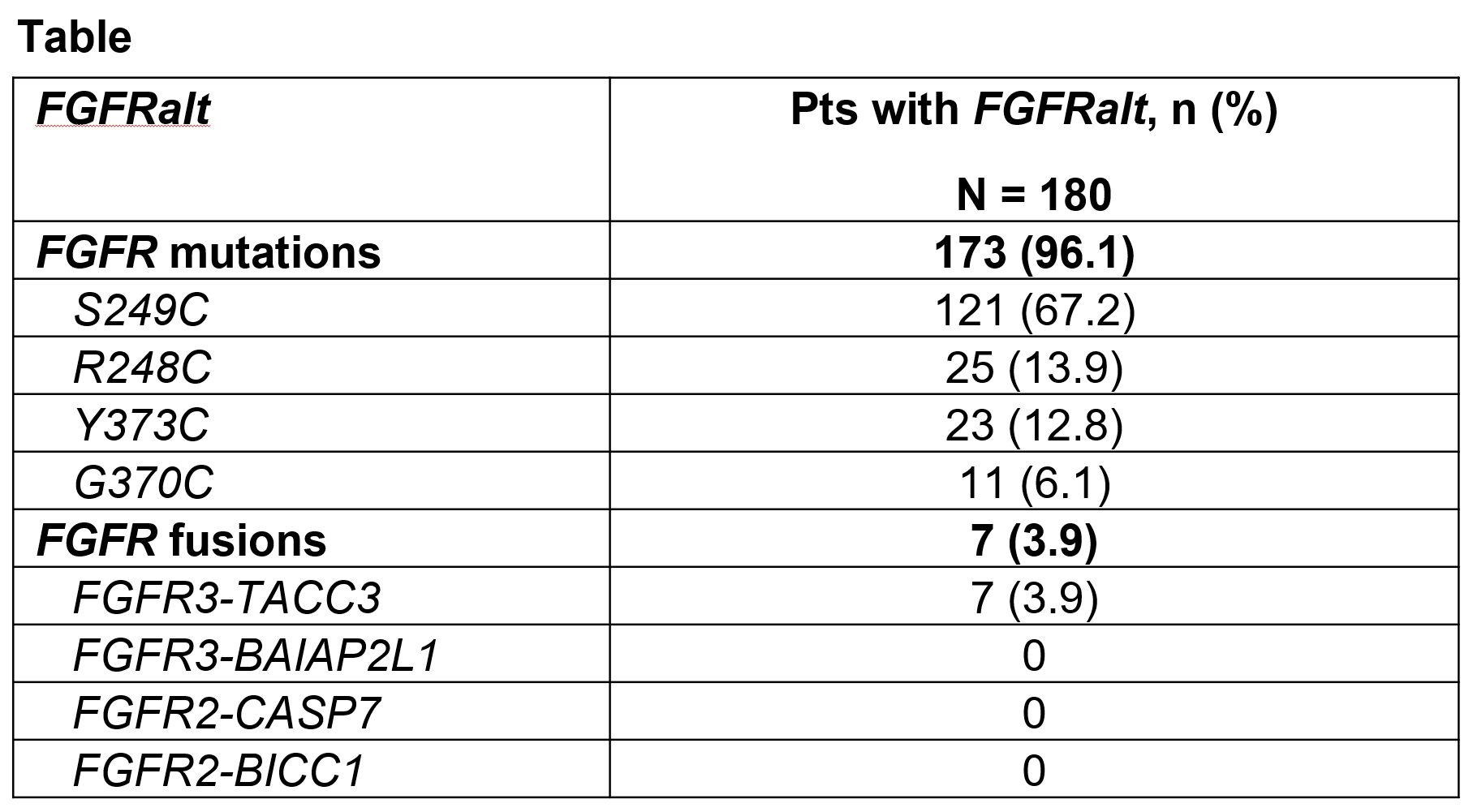Back
Poster, Podium & Video Sessions
Moderated Poster
MP59: Bladder Cancer: Non-Invasive III
MP59-05: Frequency of Fibroblast Growth Factor Receptor Alterations and Association With Bacillus Calmette-Guerin Outcomes in a Real-World Genomic Analysis of High-Risk Non-Muscle-Invasive Bladder Cancer (GARNER) Study
Monday, May 16, 2022
1:00 PM – 2:15 PM
Location: Room 225
Tahlita C.M Zuiverloon, Florus C. de Jong*, Rotterdam, Netherlands, Jenna Cody Carcione, Ramesh Sundaram, Titusville, NJ, Yoichiro Shibata, Durham, NC, Spyros Triantos, Ademi Santiago-Walker, Mahadi Baig, Titusville, NJ

Florus Christiaan De Jong
Erasmus MC Cancer Institute
Poster Presenter(s)
Introduction: Transurethral resection of bladder tumor (TURBT) followed by intravesical bacillus Calmette-Guérin (BCG) for 1-3 years is a standard treatment for high-risk non-muscle-invasive bladder cancer (HR NMIBC). While no biomarkers exist to predict BCG response, fibroblast growth factor receptor alterations (FGFRalt) occur in HR NMIBC. In this real-world study, we retrospectively assessed the frequency and predictive value of FGFRalt in BCG-treated patients (pts) with HR NMIBC.
Methods: Molecular profiling was performed by whole-exome, whole-transcriptome sequencing or SNaPshot analysis in pts with HR NMIBC (defined as high-grade Ta, T1, or carcinoma in situ [CIS]) who received TURBT and BCG at Erasmus University Medical Center in Rotterdam, Netherlands. FGFR+ was defined by = 1 FGFR3 mutation (S249C, Y373C, R248C, G370C) and/or FGFR2/3 fusion (FGFR2-CASP7, FGFR2-BICC1, FGFR3-TACC3, and FGFR3-BAIAP2L1). Primary objectives were the frequency of FGFRalt and predictive value on recurrence-free survival (RFS) with BCG treatment. Secondary objectives included assessing the predictive value of FGFRalt on progression-free survival (PFS) and disease-specific survival (DSS) post BCG. Two-sided nominal p values are provided.
Results: Of 594 pts with available FGFRalt data (mean age, 69.6 years; 79.5% male), 180 (30.3%) had prespecified FGFR+ tumors (173/594 [29.1%] had FGFR3 mutations; 7/594 [1.2%] had FGFR2/3 fusions; Table). No significant difference in RFS was observed between FGFR+ and FGFR- pts (hazard ratio, 0.74 [95% CI, 0.52-1.06]; p = 0.098). Multivariate analysis showed no effect of FGFR status, sex, age, smoking status, tumor grade (WHO 1973), and CIS at TURBT on RFS. PFS (hazard ratio, 0.77 [95% CI, 0.54-1.10]; p = 0.154) and DSS (hazard ratio, 0.76 [95% CI, 0.46-1.27]; p = 0.296) were similar between FGFR+ and FGFR- pts. Among 174 pts with available FGFRalt data pre and post BCG, FGFRalt status was maintained post BCG for most (54 [31%] pts had FGFRalt pre vs 51 [29%] post BCG).
Conclusions: Overall, 30.3% of pts with HR NMIBC had FGFR+ tumors and pts with HR NMIBC had similar outcomes post BCG regardless of FGFR status.
Source of Funding: Janssen Research & Development, LLC

Methods: Molecular profiling was performed by whole-exome, whole-transcriptome sequencing or SNaPshot analysis in pts with HR NMIBC (defined as high-grade Ta, T1, or carcinoma in situ [CIS]) who received TURBT and BCG at Erasmus University Medical Center in Rotterdam, Netherlands. FGFR+ was defined by = 1 FGFR3 mutation (S249C, Y373C, R248C, G370C) and/or FGFR2/3 fusion (FGFR2-CASP7, FGFR2-BICC1, FGFR3-TACC3, and FGFR3-BAIAP2L1). Primary objectives were the frequency of FGFRalt and predictive value on recurrence-free survival (RFS) with BCG treatment. Secondary objectives included assessing the predictive value of FGFRalt on progression-free survival (PFS) and disease-specific survival (DSS) post BCG. Two-sided nominal p values are provided.
Results: Of 594 pts with available FGFRalt data (mean age, 69.6 years; 79.5% male), 180 (30.3%) had prespecified FGFR+ tumors (173/594 [29.1%] had FGFR3 mutations; 7/594 [1.2%] had FGFR2/3 fusions; Table). No significant difference in RFS was observed between FGFR+ and FGFR- pts (hazard ratio, 0.74 [95% CI, 0.52-1.06]; p = 0.098). Multivariate analysis showed no effect of FGFR status, sex, age, smoking status, tumor grade (WHO 1973), and CIS at TURBT on RFS. PFS (hazard ratio, 0.77 [95% CI, 0.54-1.10]; p = 0.154) and DSS (hazard ratio, 0.76 [95% CI, 0.46-1.27]; p = 0.296) were similar between FGFR+ and FGFR- pts. Among 174 pts with available FGFRalt data pre and post BCG, FGFRalt status was maintained post BCG for most (54 [31%] pts had FGFRalt pre vs 51 [29%] post BCG).
Conclusions: Overall, 30.3% of pts with HR NMIBC had FGFR+ tumors and pts with HR NMIBC had similar outcomes post BCG regardless of FGFR status.
Source of Funding: Janssen Research & Development, LLC


.jpg)
.jpg)